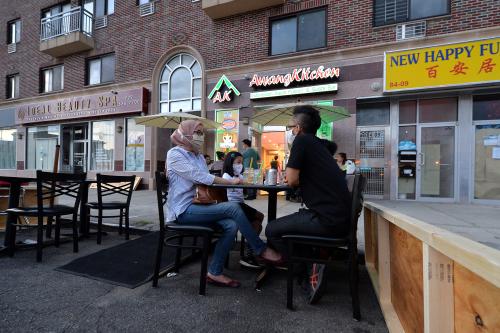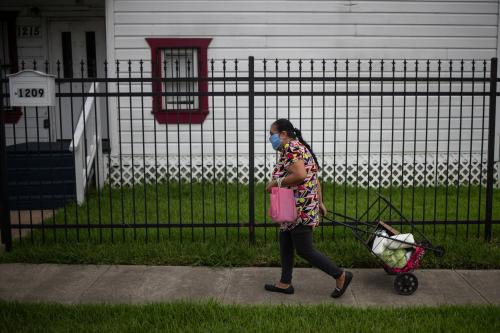In a Wall Street Journal op-ed earlier this week, President Trump and Secretary of Housing and Urban Development Ben Carson vowed to protect America’s suburbs. But which suburbs are they protecting, exactly?
Let’s concede that “the suburbs” is a roomy and imprecise term, one that researchers have defined in a number of different ways. By one definition often used in Brookings research, the suburbs are comprised of more than 31,000 neighborhoods in thousands of jurisdictions that span almost 600 counties. Given the scale of American suburbia, talking about “the suburbs” writ large invariably papers over the differences that exist across this spectrum of communities, which range in population (from fewer than 100 residents to hundreds of thousands), location (from streetcar suburbs to exurbs), and built environment (from strip malls and subdivisions to dense, walkable downtowns). As author Amanda Kolson Hurley has shown, America’s suburbs have always been much more diverse—in form and economic, racial, and ethnic makeup—than popular stereotypes suggest.
In their op-ed, President Trump and Secretary Carson acknowledge the increasing racial and ethnic diversity of the suburbs. They nod to research from Brookings’s own William H. Frey, who finds that the majority of every major racial and ethnic group in the U.S. now lives in suburbs. “We believe the suburbs offer a wonderful life for Americans of all races and backgrounds,” Trump and Carson write, but only “when they are allowed to grow organically, from the bottom up.”
That’s the trick with “the suburbs.” Yes, most people in the nation’s major metro areas—whether white, Black, Asian American, or Latino or Hispanic—live in the suburbs. But they don’t live in the same suburbs. And that sorting did not happen “organically.” It’s the product of exclusionary zoning and land use regulations as well as arduous development processes adopted by local officials and communities—practices should be anathema to an administration that has been intent on slashing regulations and shrinking government. These practices have allowed certain jurisdictions and neighborhoods to hoard wealth and opportunity, fueling racial and economic segregation and creating disparities not only between suburbs and cities but also within suburbia as well.
When Trump and Carson vow to protect a “shining example of the American Dream,” they’re talking about single-family residential neighborhoods, a form of suburbs that have already proven adept at protecting themselves. Although single-family neighborhoods have been on the rise across metropolitan America over the last few decades, they still represent fewer than one in five suburban neighborhoods. While we may not be building as many of them these days, duplexes, triplexes, fourplexes, and other kinds of apartments—yes, even the occasional high-rise—already exist in most suburbs.
Collectively, single-family neighborhoods (here defined as neighborhoods where at least 90% of the housing stock is detached single-family homes) conform to the idyllic suburban stereotype Trump and Carson are trying to evoke. Poverty rates tend to be low and typical incomes high, as are home prices and rents (Table 1). And more than 80% of these neighborhoods are majority-white, while just 5% are majority-Latino or Hispanic and 4% are majority-Black.
Table 1. Characteristics of single-family neighborhoods in the suburbs
| Suburban Single-Family Neighborhoods | Rest of the Suburbs | United States | |
| Poverty Rate | 6% | 12% | 14% |
| Median Household Income | 96,654 | 64,655 | 60,293 |
| Median Home Value | 297,200 | 223,600 | 204,900 |
| Median Gross Rent | 1,477 | 1,123 | 1,023 |
Source: Author analysis of American Community Survey 2018 5-Year Estimates
What about the four in five suburbanites who didn’t organically find their way into these neighborhoods? Not surprisingly, they are more likely to be people of color, rent their homes, and have lower incomes. Some of them live in places that used to be more affluent suburban enclaves but have since fallen on harder economic times, perhaps because a local factory closed or older housing has deteriorated. Trump and Carson denigrate “urban cities” by writing that they often struggle to “provide for their citizens’ basic needs in housing, public safety and education”—but that is also the reality for many small, resource-strapped suburbs scattered across the fragmented patchwork of suburban America.
If the Trump administration really wants to “save our suburbs,” rather than spend so much time and effort dismantling fair housing regulations meant to redress long-standing disparities and inequities, it should start with the places and people that actually need the help. It could, for instance, focus on the needs of 17 million suburban renters, nearly half of whom already faced high cost burdens before the COVID-19 pandemic left millions unemployed and at risk of eviction. It could commit to delivering rent relief and tenant protections to keep people in their homes, and ensure states and localities have the federal aid they need to keep their critical services and infrastructure functioning.
But it seems likely that Trump and Carson are less concerned about the future of all of the nation’s suburbs than they are about potential voters in a small, privileged slice of metropolitan America. Those suburbs not only fail to represent America’s future—they don’t even mirror its present.







Commentary
Trump is clinging to an outdated vision of America’s suburbs
August 20, 2020